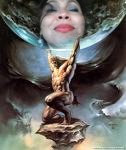ISLAM STUDY GUIDE 1 FROM HISTORYARTE BY DR. CECILIA LEVALLOIS H.
Name:_______________________________Date:________________Grade:__________
Choose the best answer from the four options and circle its letter only.
1. Omar Khayyam was:
a. A Persian poet who wrote the Rubaiyat.
b. A dissident son of Muhammad the prophet.
c. The first caliph of the Umayyad dynasty.
d. None of the above.
2. Muhammad:
a. Was the founder of Islam, was persecuted and fled to Medina while trying to win his struggle.
b. Was the loving second husband of rich Khadija, for whom he worked.
c. Put together the Qu{ran and established Allah as the only god.
d. All the above.
3. The kaaba:
a. Is located under the Kremlin in Russia.
b. Is a huge black stone around which Muslim pilgrims pray during the Haj.
c. Is a tool box where Jews put away their implements.
d. Contains many left hands of people who used them for clean deeds.
4. All these empires were based on Islamic beliefs and practices:
a. Mongol, Byzantine, Osmanli and Roman.
b. Ottoman, Umayyad, Safavid, Mughal .
c. Osmanli, Ottoman, Persian and Greek.
d. Mongol, Mughal, Ottoman and Byzantine.
5. Powerful women in the Islamic empires were:
a. Theodora of Byzantium, princess Zuleika of Serbia, Bas kadin Khurrem.
b. Empress Nur jehan of the Mughal Empire, Bas Kadin Khurrem of the Ottoman empire, Empress Mumtaz Mahal of the Mughal dynasty.
c. Princess Zuleika of Serbia, ikbal Sechir Para of the Ottoman Empire, bas-khadin Nurbanu of the Ottoman empire.
d. None of the above.
6. Widespread Islamic customs include:
a. Burping discreetly to praise the cook after eating.
b. Passing wind through the lower body to praise the cook before eating.
c. Never using the left hand except for dirty tasks.
d. Only a and c
7. Women held ranks in the Ottoman empire in this fashion:
8. This was the hierarchy in Ottoman Turkey:
a. Sultana valideh as mother of the reigning sultan, bas kadin as head wife, kadin after bearing a male child, ikbal upon being the sultan´s lover or bearing him a daughter, and guzdeh when the lady was already having a sexless romance with the sultan.
b. Ikbal as the most powerful in charge of the eunuchs of the harem, the sultana valideh if she managed to kill the sultan.
c. sha if the lady had a boy cild, voivode if she had a girl child and guzdeh if she just flirted with the sultan.
d. all of the above.
9. The sword of Ayub was the weapon used during the ceremony in which the new sultan was anointed in the Ottoman succession.It followed as:
a. A swing at the feet to test the new monarch´s agility, a slap in the buttocks to remind him the people could rep´rimand him, and pouring of olive oil on his ears so he heard well.
b. A light touch on the head with the sword, to remind him to be wise, another on the chest to have his heart love his people, another touch at the testes to wish him a good son to follow him, and another at his feet so he could guide his people along the right path.
c. A slap on the cheek to make him blush and learn humility, a touch on the belly to remind him to feed his people and a nudge on his cat to remind him to be an ecological sovereign.
d. None of the above.
10. Sultan Mehmet II the Conqueror or Fatih of Bizantium dictated the laws of succession as:
a. All brothers and sisters should be bowstringed when the new sultan prepares to take oath after the old sultan dies, and buried in mausoleums.
b. All male siblings of the new sultan should be killed, but not by the new monarch because Islam forbids brother killing brother. This is to avoid rivalries. Women siblings are not to be killed, but her male sons yes.
c. The mother of the new sultan should be quickly strangled to avoid her meddling in the whole affaire.
d. All of the above
11. The Umayyad empire or caliphate :
a. was the second of the four major Islamic caliphates established after the death of Muhammad. It was ruled by the Umayyad dynasty, whose name derives from Umayya ibn Abd Shams, the great-grandfather of the first Umayyad caliph. Although the Umayyad family originally came from the city of Mecca, their capital was Damascus.
b. We owe their bankers the invention of the check.
c. They invented ice cream, rugs and they had a prince named Tariq who committed suicide after he went to Spain.
d. A and b only.
12. . In January 750 in the Battle of the Zab, the Umayyads were defeated. Damascus fell to the Abbasids in April, and in August royal Marwan was killed in Egypt.What happened next to the Umayyads?
a. One grandson of Hisham,a proud prince named Abd ar-Rahman I, survived and established a kingdom in Al-Andalus (Moorish Iberia).
b. They called Byzantium for help but never got it.
c. Alexander the Great saved them and put Hisham back on the throne.
d. None of the above.
13.This was the social division in the Umayyad Empire: The Umayyad Caliphate exhibited four main social classes:1.Muslim Arabs2.Muslim non-Arabs (clients of the Muslim Arabs)3.Non-Muslim free persons (Christians, Jews, and Zoroastrians)4.Slaves. Thus:
a. The Muslim Arabs were at the top of the society, and saw it as their duty to rule over the conquered areas.
b. the non Muslims were second class citizens but could worship as they pleased.
c. Christians were crucified.
d. only a and b.
14. Abbasid Empire:
a. is named thus because of their prominent relative of Muhammad .
b. was the third of the Islamic caliphates. It was ruled by the Abbasid dynasty of caliphs, who built their capital in Baghdad after overthrowing the Umayyad caliphate from all but the al-Andalus region.
c. went to war often against the Roman empire.
d. a and b only.
15. The Safavid empire:
a. was one of the most significant ruling dynasties of Iran. They ruled one of the greatest Persian empires after the Muslim conquest of Persia.
b. The Safavids ruled from 1501 to 1722 (experiencing a brief restoration from 1729 to 1736) and at their height, they controlled all of modern Iran, Azerbaijan and Armenia, most of Iraq, Georgia, Afghanistan, and the Caucasus, as well as parts of Pakistan, Turkmenistan and Turkey. Safavid Iran was one of the Islamic "gunpowder empires", along with its neighbours, the Ottoman and Mughal empires.
c. the first main ruler was Timur Lenk.
d. a and b.
16. The Janissaries were:
a. an elite corps, the royal guard of the Ottoman sultan, formed by young Christian boys from conquered territories, specially trained for choicest missions.They were infantry units that formed the Ottoman Sultan 's household troops and bodyguards . The force was created by the Sultan Murad I in 1383 and was abolished by Sultan Mahmud II in 1826 in the Auspicious Incident
b. sometimes they deposed or anointed sultans, depending on the capacity of the reigning ruler. From 1380s to 1648, the Janissaries were gathered through the devşirme system. This was the recruiting of non-Turkish children, notably Balkan Christians; Jews were never subject to devşirme, nor were children from Turkic families. In early days, all Christians were enrolled indiscriminately; later, those from Albania, Greece, Bosnia, Serbia and Bulgaria were preferred
c. they were created by Sha Tamasp of the Safavid empire to go and attack the Mughals.
d. a and b only.
17. The Mevlevi order of dervishes:
a. were elegant and tall religious monks of the Sufi order who danced to praise Allah. / Mevleviye is a Sufi order founded in Konya (in the Ottoman Empire ) by the followers of Jalal ad-Din Muhammad Balkhi-Rumi , a 13th-century Persian poet , Islamic jurist , and theologian . They are also known as the Whirling Dervishes due to their famous practice of whirling as a form of dhikr (remembrance of God
b .were present at the anointment of sultans while the new ruler received the sword of Ayub in a ceremony.
c. after their first ten performances were sold off as slaves to the Mughal monarchs.
d. a and b only.
18. The Mughal empire:
a. was created by the Timurid descendant Babur the Tiger, when he defeated sultan Ibrahim Lodi in the First Battle of Panipat in April 1526.
b. Babur the Tiger was not only the first Mughalmonarch but also a self-taught journalist who wrote the Baburnama.
c. his son Humayun, who was a weak and intellectual diabetic, was left as his heir when Babur died.
d. all of the above.
19. Going down the Mughal dynasty:
a. Weak Humayun lost his throne due to his inexperience, and while his usurper was ruling in India, and having to flee from city to city, Humayun eventually sought refuge at the court of Tahmasp. Tahmasp, who refused to hand him over to his brother, greeted Humayun at his court in Qazvin as the true emperor of the Mughal dynasty, despite the fact that Humayun had been living in exile for more than fifteen years Humayun managed to regain his throne, only to die from a fall down the stairs when he had an attack of neuropathies.
b. Humayun was the father of the great, wise, vegetarian and tolerant Akbar the Great, best ruler of India.Akbar the Great was patron of the arts and sciences, refused to eat meat yet when he died his son Jahangir held a party to celebrate his demise.
c. Jahangir son of Akbar, husband to beautiful and manipulating Noor Jehan, was a weak ruler who let his wife rule for him while he was on a drunken spell. Father to Sha Jahan, who ended up building the Taj Mahal with the aid of 1000 elephants after his adored wife Mumtaz Mahal died in childbirth in the Deccan having his fourteenth baby.
d. all the above is fact.
20. Aurangzeb, last strong ruler of the Mughal dynasty,
a. was the son of Sha Jahan who deposed his grieving dad and had him locked in the Red Fortress. From his window the white haired Sha Jahan mournfully saw how the Taj was being built. He buried his wife there, and when he died, he was buried there. Aurangzeb also killed two of his brothers to snatch the throne.
b. Aurangzeb was a builder ruler, raised taxes for non Muslims, studied the blue snouted bats of India and stuffed a few of them for future studies, was a fanatic Muslim.
c. He was of the view that royal treasury does not belong to king but common man. He did not use any of the royal treasury for him and his family. In fact, he used to copy and sell his editions of holy Qur'an and earn money for it, and his wife used to weave caps and copies of the holy quran to support his earnings.
d. all of the aforementioned.





